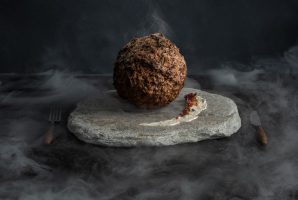[ad_1]
Pitching their expertise as an answer to local weather change – and utilizing the mammoth as “a monumental image of what we stand to lose now” – Vow unveiled its newest experiment in cultured meat (flesh grown from animal cells) in Amsterdam on Tuesday evening, Australian time, on the Meals Futurism convention.
The meat was produced utilizing molecular engineering that concerned cells inserted with actual mammoth DNA with gaps within the sequencing stuffed by African elephant DNA, the mammoth’s closest residing relative.
The Western Sydney-based startup started producing lab-grown meat from pork and kangaroo cells in 2019. It’s since produced flesh from a spread of animal cells, together with rabbit, mice, goat and water buffalo, and even alpaca. It’s explored placing greater than 50 species of lab-grown meat on plates, together with fish.
Vow is backed by Australia’s main enterprise capital funds, together with Blackbird and Sq. Peg, in addition to Grok, the household fund of Mike Cannon-Brookes. It raised $7.7 million in a seed spherical in January 2021, then a report $73.5 million Collection A in November final 12 months.

Vow’s lab-grown mammoth meatball. Photograph: Aico Lind.
Bringing a theatricality worthy of PT Barnum to Vow’s science and story, the idea for a mammoth meatball was developed by Bas Korsten, chief inventive officer at promoting company Wunderman Thompson. Korsten was chargeable for the 2016 mission The Subsequent Rembrandt, a synthetic intelligence 3D-printed portray produced after the AI trawled the entire works of the Dutch Renaissance painter.
A slick video calling on regulators to maintain up with the altering expertise Vow is pioneering was launched as a part of the mammoth meatball mission, arguing the startup has the answer to local weather change. It ends with the tagline “Let’s eat our method out of extinction”.
Vow cofounder Tim Noakesmith says within the video that “we wish to change everybody’s conception of what meat is”, including that the corporate’s ambition is “to feed billions of people”.
“Cultured meat considerably reduces the local weather change impacts that’s usually related to common meat manufacturing,” he mentioned.
“The world wants cultured meat now.”
Singapore is the one nation on the earth the place cultured meat is authorized for human consumption. Vow is planning to serve cultured quail meat there in an idea restaurant referred to as Morsel presently providing signal ups to strive a “world-first dish”.
Noakesmith argues that cultured meat may be designed for each style and dietary worth to regular meat alongside its environmental advantages.
The startup enlisted College of Queensland Prof Ernst Wolvetang from the Australian Institute for Bioengineering to develop the mammoth meat, utilizing sheep myoblast stem cells to get issues replicating.
The Mauritian dodo was the unique plan, however that concept was thwarted by the truth that the DNA sequence doesn’t exist, although there’s common discuss of bringing the flightless chook again to life 370 years after people wiped it out.
It’s most likely for the most effective because the dodo is usually used as an exemplar of the triumph of tech over those that fail to adapt rapidly sufficient.
A 2021 paper ready by London assume tank Chatham Home argued that the manufacturing of meals is the first reason for biodiversity loss globally.
In a world the place so many animals are presently being pushed to extinction, not out of a determined want for his or her flesh, however as a result of they’re a cult craving, a superstitious drugs, a worthwhile byproduct, or just worn out by land clearing to be able to develop crops (does that embrace legumes for plant-based “meat”?) and livestock, in addition to for improvement for rising populations, the problem for Vow and its buyers is whether or not it ought to produce proteins everybody can afford, or cater for the joys and excessive revenue margins of consuming lab-grown meat that’s not simply the product of lifeless animals, however even extinct ones.
Tassie tiger snags, anybody?
Right here’s the mammoth meatball video:
[ad_2]
Source link


